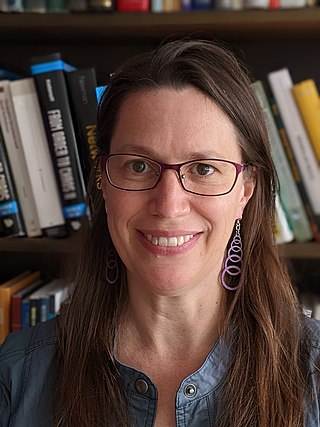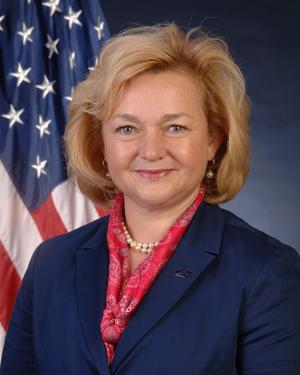Related Research Articles
The National Society of Hispanic Physicists (NSHP) was established in 1996 with the goal of promoting the participation and advancement of Hispanic-Americans in physics and celebrating the contributions of Hispanic-American physicists to the study and teaching of physics.
Ramón E. López is a Puerto Rican physics professor at the University of Texas at Arlington whose research focuses on space physics and science education. He is an elected fellow of the American Physical Society (1999) and the recipient of its 2002 Dwight Nicholson Medal for Outreach for his contributions to science education. He is also an elected fellow of the American Association for the Advancement of Science (2011).
Julia Wan-Ping Hsu is an American materials scientist. In her research, she uses scanning probe microscopy to study the nanostructure, optics, and photoelectric properties of thin films and crystal surfaces, with particular application to solar cells, and has used nanotransfer printing to make electrical connections to single-molecule sensing devices. She is a professor of materials science and engineering at the University of Texas at Dallas, where she holds the Texas Instruments Distinguished Chair in Nanoelectronics.
Andrea Jo-Wei Liu is the Hepburn Professor of Physics at the University of Pennsylvania, where she holds a joint appointment in the Department of Chemistry. She is a theoretical physicist studying condensed matter physics and biophysics. She is particularly known for her study of jamming, a phenomenon in which disordered materials become rigid with increasing density and stress. She is a Simons Investigator and Simons Fellow in Theoretical Physics, fellow of the American Physical Society (APS), the American Association for the Advancement of Science (AAAS), the American Academy of Arts and Sciences, and a member of the National Academy of Sciences (NAS).

Karen E. Daniels is an American physicist who is a professor of physics at North Carolina State University. Her research considers the deformation and failure of materials. She is a Fellow of the American Physical Society, and serves on their Committee on the Status of Women in Physics. She is also a Fellow of the American Association for the Advancement of Science.
Noel Anthony Clark is an American physicist, university professor at the University of Colorado Boulder, and pioneer in the development of electro-optical applications of liquid crystals.

Angela Renee Hight Walker is an American physicist. She is a project leader in the nanoscale spectroscopy group at the National Institute of Standards and Technology. Hight Walker's research includes advancing optical spectroscopic techniques and specifically their applicability to characterize quantum nanomaterials.

Susan Buthaina Sinnott is professor and head of materials science and engineering at Pennsylvania State University. Sinnott is a fellow of the Materials Research Society (MRS), the American Association for the Advancement of Science (AAAS) and the American Physical Society (APS). She has served as editor-in-chief of the journal Computational Materials Science since 2014.
Jacqueline Krim is an American condensed matter physicist specializing in nanotribology, the study of film growth, friction, and wetting of nanoscale surfaces. She is a Distinguished University Professor of Physics at North Carolina State University.
Lisbeth Dagmar Gronlund is an American physicist and nuclear disarmament expert, the former co-director of the Global Security Program for the Union of Concerned Scientists.
Sandra Marina Troian is an American applied physicist known for her research on fluid dynamics, quasicrystals, surface science, thin films, microfluidics, and spacecraft micropropulsion. She is a professor of Applied Physics, Aeronautics, and Mechanical Engineering in the Division of Engineering and Applied Science of the California Institute of Technology (Caltech), and head of the Laboratory of Interfacial and Small Scale Transport in the Department of Applied Physics and Materials Science at Caltech.
Clare McCabe is an American chemical engineer who is Cornelius Vanderbilt Chair of Engineering and professor of engineering at Vanderbilt University. She was elected Fellow of the American Association for the Advancement of Science in 2019. Her research makes use of molecular modelling to understand the properties of biological systems, fluids and nanomaterials.
Huili Grace Xing is the William L. Quackenbush Professor of Electrical and Computer Engineering, and Materials Science and Engineering in the Cornell University College of Engineering. In 2019, Xing was elected a Fellow of the American Physical Society (APS) "for pioneering contributions in polar wide-bandgap semiconductors, 2D crystal semiconductors and layered crystals," as well as Fellow of the American Association for the Advancement of Science (AAAS) in 2021.
April S. Brown is an American electrical engineer and materials scientist in the Duke University Pratt School of Engineering, where she is a professor of electrical and computer engineering and the former John Cocke Professor of Electrical and Computer Engineering.
Rachel Goldman is an American scientist. She is professor of materials science and engineering, electrical engineering and computer science, and physics at the University of Michigan where she has been a faculty member since 1997. She also serves as the associate director of applied physics at the University of Michigan since 2010.
Barbara A. Jones is an American physicist who works for IBM Research in San Jose, California, in the Quantum Applications group of IBM Quantum. Her research involves the quantum dynamics of magnetic systems.
Ximena Cid is a Chicana and Indigenous American physicist; physics educator and physics education researcher; and advocate for increasing diversity and supporting minority students in STEM and physics. She is currently associate professor and past chair of the physics department at California State University Dominguez Hills. She is recognized as the first Latina student, as well as the first Indigenous student, to earn a PhD in physics from the University of Texas at Arlington. She is also recognized as likely the first Indigenous person to chair a physics department in the country. One of her research specialties is 3-D simulations to support the comprehension of systems such as gravitational fields, electric fields and magnetic fields.
Joan M. Redwing is an American materials scientist known for research on electronic and optoelectronic materials, including the processing of semiconductor thin films and nanomaterials by metalorganic chemical vapor deposition (MOCVD). Redwing is a distinguished professor of materials science and engineering and electrical engineering at Pennsylvania State University and director of the university's 2D Crystal Consortium research facility. She is a fellow of the American Association for the Advancement of Science, the American Physical Society, and the Materials Research Society.
Evgenya Ivanovna Simakov is a Russian-American physicist whose research has involved photonic crystals, metamaterials with engineered band gaps that can be used to suppress unwanted resonances in particle accelerators. She has also worked on the design of small portable particle accelerators, and the use of nanoscale arrays of diamonds to control the shape of electron beams. She is a researcher at the Los Alamos National Laboratory.
Robin Lillian Blumberg Selinger is an American materials scientist. She is professor of physics at Kent State University and the Advanced Materials and Liquid Crystal Institute. In 2016, Selinger became the first female Kent State University faculty member to be elected a Fellow of the American Physical Society.
References
- 1 2 3 "Luz Martinez-Miranda is a 2020 ADVANCE Honoree". mse.umd.edu. Retrieved 2023-09-11.
- 1 2 Martinez-Miranda, Luz (2002). SACNAS (ed.). "SACNAS Biography Project" (PDF).
- 1 2 "Luz Martinez-Miranda - Physicist Profile Detail Page". www.compadre.org. Retrieved 2023-09-12.
- ↑ "Luz Martinez-Miranda - professor".
- 1 2 3 4 Madren, Carrie (23 September 2011). "Luz Martinez-Miranda riding new wave in liquid crystal research". AAAS. Retrieved 11 September 2023.
- 1 2 3 "Luz Martinez Miranda".
- ↑ "APS Fellowship". www.aps.org. Retrieved 2017-04-20.
- ↑ "APS Fellow Archive". www.aps.org. Retrieved 2017-04-20.
- ↑ "APS Fellows 2007". www.aps.org. Retrieved 2017-04-20.